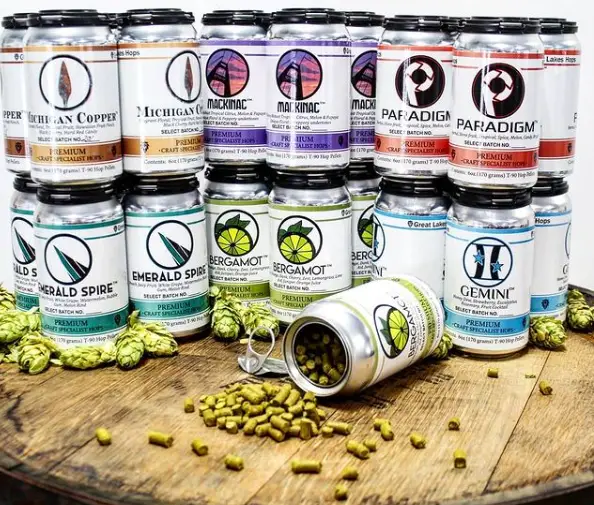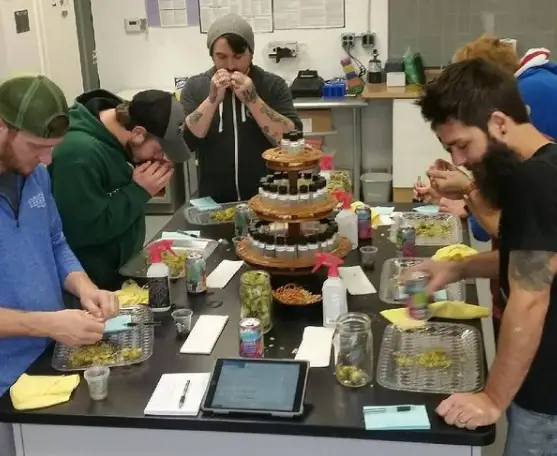
The creativity of homebrewers is endless and we are passionate about creating unique and delicious beer. In my quest for rare hops from small hop farms, Etsy came to mind. I didn’t hold up much hope, but to my surprise I found Great Lakes Hops selling hops in cans!
Great Lakes Hops sells rare and unique hops in cans. These hops are their own proprietary creation and currently include 6 different varieties. These hops come in cans of 6oz and include many fruity aromas. Currently they are only available on Etsy and select homebrew stores.
These hops just seemed too good to be true, I had to learn more. So I reached out and was able to have a nice chat with Chris Vogel who is in charge of hop trial programs at Great Lakes Hops.
Read below to see what Chris had to say about these unique hops (Etsy Link) and how a company that started by specializing in succulents is becoming a proprietary hop powerhouse.
The Decision to Sell Unique Pellet Hops in Cans
Hops are typically sold in packets of either 1oz, 2oz, or 8ozs. This allows the brewer to control the precise amount of hops they want to add to their brew, down to the ounce. This makes a recipe precise but increases the cost per ounce of hops.
Great Lakes Hops decided to sell their hops in what you would typically be drinking a cold brew out of. I wondered if it was strictly novelty they were going for, but it seemed so off the wall there might be another reasoning behind it.
Q: What was the reasoning behind selling hop pellets in cans, are there any benefits to it?
Chris: The homebrewer market didn’t have much interest in one ounce packs and we needed a larger quantity as a promotional item for breweries. Six ounce cans offered a fun and approachable item for homebrewers and breweries alike.
One recyclable can was also a much more streamlined and a green way to package our product rather than using multiple packets, plus its recyclable and 6oz of hops fit perfectly!
That streamlined efficiency is certainly working. It only costs 16 dollars for one can purchased off Etsy. If you don’t count shipping fees the price for one can is square in the mid range price for 1 ounce of hops.
For a specialty hop with high demand it is certainly a competitive price point for even 8 ounces of the more expensive hops.
Its not just the price that is astounding, its the unique aromas that their hops impart that are really interesting. Their most popular offering Mackinac, sports a heavy robust tropical citrus, melon, and papaya. With a unique floral and peppery undertone.
The Unusual Choice to Sell Canned Hops on Etsy
Many homebrewers turn to their local homebrew store or some of the major online sites for their hops, but there is also another class of homebrew hobbyists who love to grow their own hops and you can find many whole cone hops available on Etsy.
After asking a friend of mine what he thought about these hops on Etsy, he replied with, “They seem a bit suspect.” Maybe Chris Vogel can change his mind.
Q: What made you choose Etsy to sell your proprietary hops on and is there anywhere else that you can find them?
Chris: The Etsy market is full of plant lovers. A lot of Homebrewers plant hops in their backyard. Etsy was the same sales our parent company Dutch Touch Growers used to sell succulents, so we were familiar with it.
We are also working exclusively with Hang em High Hops to offer cans on their site and working with local homebrew shops.
Chris further explained that the target demographic for the canned hops was homebrew clubs and meant to be as a cool gift that family members could give to the brewer in their life.
Chris also mentioned that if the canned hops remain popular there is no reason for them to be phased out. The varieties will eventually reach a point of mass production where they will be available in smaller packages but the canned versions should stick around. Its also very likely their newest hop additions will utilize cans as an initial format of distribution.
Proprietary Hops with Big Aromas
There are six types of hops that are currently available on Etsy with a 7th that could be on its way, but is available at select homebrew stores. These hops have some interesting aromas take a look below.
- Gemini: Honey dew, strawberry, eucalyptus, rosemary, Fruit cocktail.
- Mackinac: Big tropical, citrus, melon, papaya, spice.
- Michigan Copper: Floral, tropical, fruit punch, pepper, cherry.
- Emerald Spire: Peach, juicy fruit, white grape, watermelon, skunk, bubble gum, melon rind.
- Bergamot: Mango, orange, dank, cherry, zest, lemongrass, lime aid, juniper, orange juice.
- Paradigm: Herbal, stone fruit, tropical, spice, melon, candy, bright.
- Hydra (New Addition): Bright citrus, tangerine, mandarin, clementine, green grape, orange rind.
Note that these aromas are dependent on the crop year. They may change in the future, but the goal is for them to remain as consistent as possible, while testing the aromas from year to year for any changes. You can visit Greatlakeshops.com for the most up to date information.
Just looking at the aromas of these hops gives me endless ideas. Michigan Copper would be a very interesting hop to try with a stout. Bergamot could make an interesting Hefeweizen. The possibilities are endless and really reduce the need to add more than hops, malt, yeast and water.
Identifying Hop Aroma Profiles Across Seasons
I often wondered how hop varieties got so many interesting descriptions on their labels. Great Lakes Hops in particular had some interesting aromas that almost seem too strange to be true. I wondered how they came to the conclusion that a particular hop variety had a papaya aroma.

Q: Your most popular offering is Mackinac, its described as a tropical, citrus, melon, papaya and spice flavor. That seems unique, how pronounced are those aromas?
Chris: All the hops go through a multilayer trial test. A group conducts a sensory analysis, where they smell different hops to get the more forward and lighter tones of a particular hop.
The hops then go through a brew trial and key aromas are selected to highlight. The 5 words describing the Mackinac hops are the ones that were used most in the trial. As the oils in hops develop they really start to show their flavors. Myrcene, is the oil responsible for citrus aroma.
Another way to explain the development of hop oils is alpha and beta acids are sort of like salt and pepper for the brewer. IPA’s and NEIPA’s are trying to get as much out of the oils as they can.
When it comes to hop oils we have come a long way in recent years. The secrets behind interactions between alpha and beta acids in hops is still incredibly complex and we are nowhere near its potential.
Alpha acids isomerizing in boiling wort is mainly responsible for the bitter flavor in beer. But, beta acids also play a role with aroma as they interact with alpha acids.
It would take a degree to even touch the surface of the complexity and possibilities. As we homebrewers know all too well experimentation is never-ending and key to progress.
Beer Purity and Changing Landscapes
The rise of IPA’s and NEIPA’s is changing the landscape of beer production. Because of the push for fruitier and more aromatic beers there has become a huge market for adjuncts. This raises the cost of beer and takes away from the purity of the product.
Q: What are the goals of the hop breeding program?
Chris: Our goal is not to release any two hops that are identical to anything that is currently on the market.
A pure way of looking at brewing is we strive to keep costs down by providing different aromas and varieties. This can hopefully reduce adjuncts and make beer more pure. It helps with sustainability, and beer can be more affordably produced.
I walk into most breweries and craft beers are selling for 8 dollars on average. With a wife and kids I can’t continually pay those kinds of prices on a regular basis, so I hope we can help to reduce those prices.
Not only is it great that Great Lakes Hops is cultivating many new hop variants, but they actually have a program where they work closely with independent hop growers to teach and help distribute some of their proprietary hops.
I found their hopyard map particularly entertaining as I checked my local area for some hop growers.
How to Grow Hop Plants in a Dry Climate
I have long been deterred from planting hops where I live. Its dry and hot in the Southern California Summers. But, a friend of mine decided to grow a plant anyways, and it inspired me to try my hand at it too.

Luckily, not only did I find that Great Lakes Hops sold unique hops but they also specialize in propagating hop plants. So I ordered some hop plants off their site, but as a bonus got some much needed information from Chris Vogel.
Q: Can hop plants survive in a Southern California Climate and what tips do you have for growers in drier regions?
Chris: Neomexicana class of hops were born in the desert region. These hops do well in low rainfall areas. They are used for traditional Mexican lagers. Some examples are Willow Creek, Multihead, or Medusa.
Cascade can be grown by anybody, but you will need to ensure a fertile, loamy, and fresh soil. A benefit of low rainfall is you won’t have powdery mildew issues.
Hops historically use a lot of water. But, according to the University of Nevada, drought tolerant varieties only require 30 minutes of water 3 times a week with a 5 gallon per hour emitter. That’s far less than the useless grass that dots many Southern California yards.
As you prepare to plant hops this season be sure to check out Great Lakes Hops for awesome varieties. When its time for the harvest be sure to read up on using fresh hops in a 5 gallon batch of beer.
Follow my Journey on Instagram as I grow hops and brew beer in Southern California.
